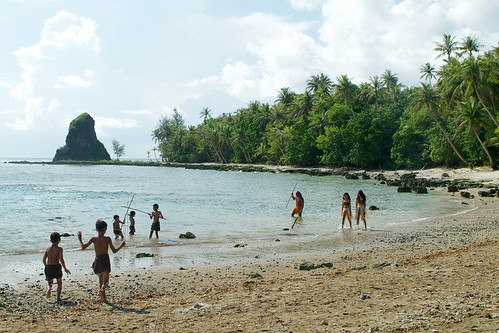Sisters and brothers
Che’lu is a Chamorro term for a sibling; brother or sister. Mañe’lu is the plural form of che’lu, referring to more than one sibling. Today che’lu is also used in casual conversation when referring to a peer or close friend. It is often used in the workplace, clubs or organizations by Chamorros as an expression of camaraderie.
Distribution of authority
In ancient Guam the importance of che’lu can be illustrated by the relationship and roles that sisters and brothers held in society. Ancient Guam was a matrilineal society in which lineage is determined from the female side of the family. Therefore, brothers and sisters (mañe’lu’) played important roles that were complimentary to each other.
The mañe’lu of the matao or Chamori, which was the higher caste in ancient Chamorro caste system and the most historically-documented class, had a unique level of authority and responsibility in the household, to the clan, and the village. The highest-ranking leaders were the eldest siblings: the maga’håga, or eldest daughter, and her male counterpart the maga’låhi, or first son. These leaders oversaw the well-being of the clan and its obligations to the village in terms or resources and social actions.
Guam historian, Dr. Anne Hattori writes that:
In the matrilineal system, brothers and sisters relied strongly upon each other to protect family property, raise the children of the family, and generate assets to keep the family well endowed. The brother-sister relationship was considered absolutely permanent and completely reliable.
Activities
The mañe’lu of the matao oversaw the well-being of the clan and its obligations to the village. All decisions were made by consensus known as todu manatungo.
French explorer Louis Claude de Freycinet, who visited the Mariana Islands in the early 19th century, conducted some of the earliest recorded scientific and ethnographic studies of Chamorros. He documented the relationship between siblings in ancient Guam as told to him by local officials. Later Laura Marie Torres Souder wrote about Freycinet’s documentation of the seniority of the oldest sisters and brothers in families in her book Daughters of the Island:
Among kin age determined rank. The oldest woman (maga’ haga) and her oldest brother (maga’ lahi) were the highest ranking individuals. Together they wielded considerable control over clan affairs and property.
The highest-ranking mañe’lu served an essential role in the societal order of Guam as this relationship made for an environment that focused on shared responsibilities of siblings to ensure the betterment of the family as a whole family unit.
Contemporary Guam
Today, the influence of western society has impacted Chamorro culture. American individualism has penetrated Chamorro society, but the importance of the interdependence of family and especially siblings (mañe’lu) remains. There is still a semblance of Chamorro society that remains in modern families such as when younger siblings might defer to the choices of their elder siblings in familial matters, although they may express or exert more of their personal opinions.
For further reading:
Bevacqua, Michael Lujan. “Mampolitiku.” In Guampedia, last modified 17 May 2021.
Freycinet, Louis Claude Desaulses de. An Account of the Corvette L’Uraine’s Sojourn at the Mariana Islands, 1819. Translated by Glynn Barratt. Saipan: Commonwealth of the Northern Mariana Islands Division of Historic Preservation, 2003.
Hattori, Anne Perez. “’Puntan and Fu’una: Gods of Creation.” In Guampedia, last modified 20 May 2021.
Souder-Jaffery, Laura Marie Torres. Daughters of the Island: Contemporary Women Organizers of Guam. MARC Monograph Series 1. Mangilao: Micronesian Areas Research Center, University of Guam, 1987.





